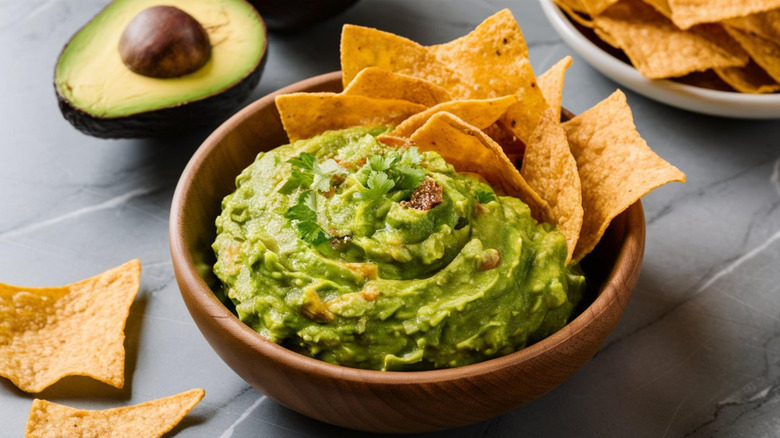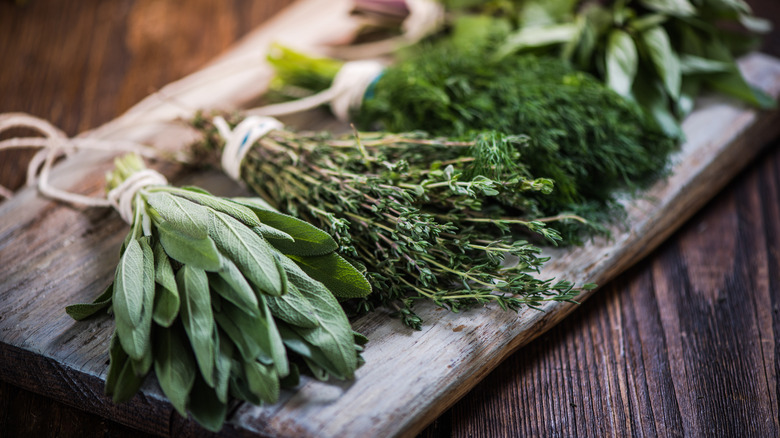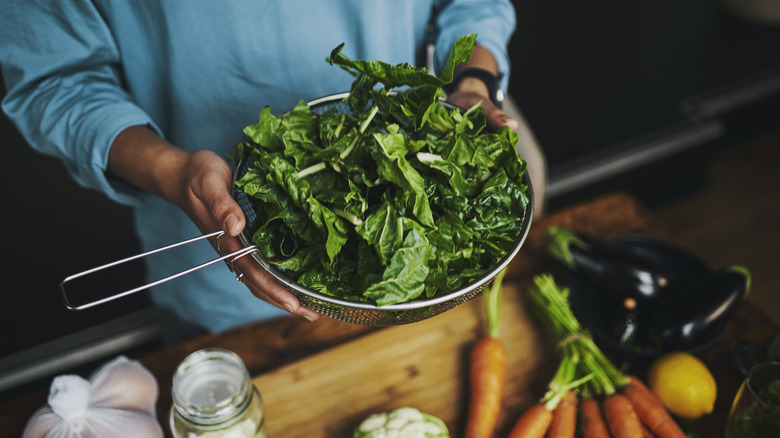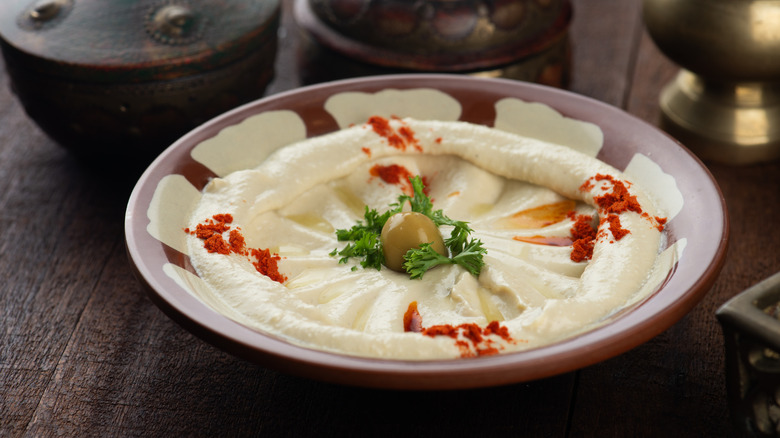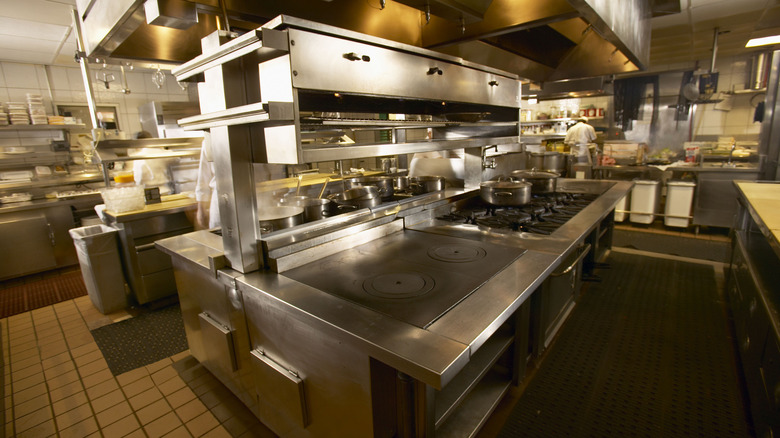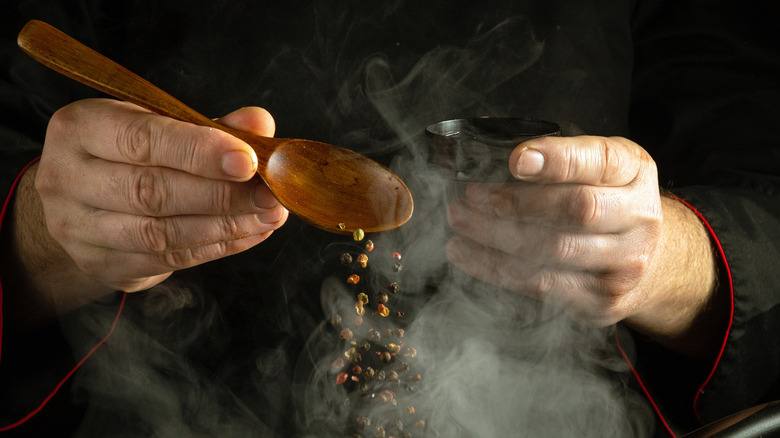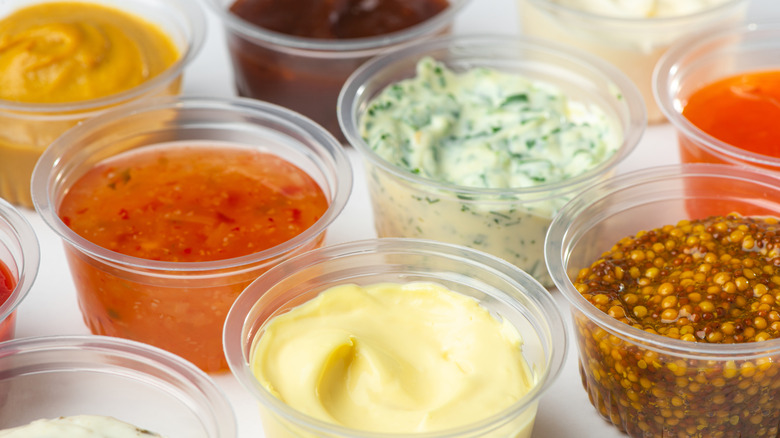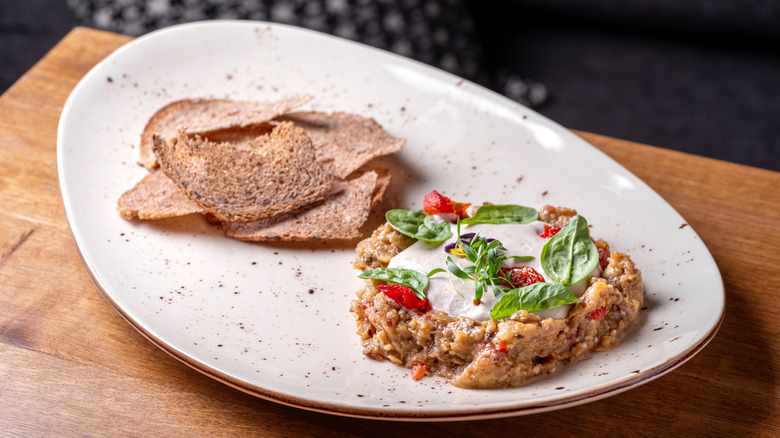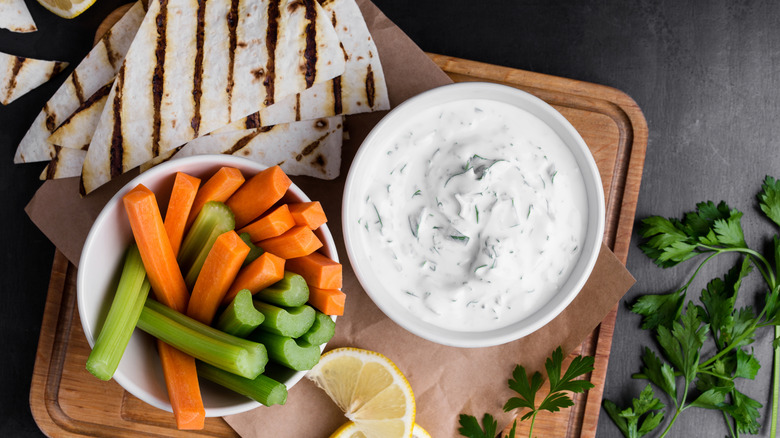Why Dips Always Taste Better At A Restaurant
In the context of the wider dining etiquette, all types of dips fall into the fun, less structured category and are never taken too seriously. They are imagined as playful and vibrant party snacks or communal appetizers, and as such, they don't get much recognition. However, dips are a great opportunity to show off creativity, and their playful character always promises a fun dining experience that has the power to set the tone for the rest of the evening or upcoming orders. That's why these seemingly minor dishes deserve more hype and recognition.
Whether warm, cold, chunky, or smooth, dips are one of the things you are equally happy to see served at home or in restaurants. In restaurant settings, dips are featured on the menus of snack bars and casual eateries, but it's also common to find them at upscale locations. At home, we like to serve them as a part of a larger snack spread or as an interlude to a more substantial meal. These home versions are rarely unsuccessful, but restaurant dips always hit differently. We tried to look into this issue to find out why home-whizzed dips are never as good as the ones at your favorite restaurant.
Restaurants don't skimp on the seasonings and fat
Among many things that differentiate professional chefs from everyday home cooks is the ability to properly season food. This is one of the reasons why your favorite dip always tastes better at a restaurant. Professional chefs go through extensive training to learn the foundations they later apply in real kitchens. The theory and practice combine in balanced, well-seasoned dishes that never call for additional tweaks. Salt is the defining part of this process. It has the power to transform and give bland-tasting food body and character, so chefs are usually generous with the amount and prefer to add it to every element. They also know which dip calls for extra heat or requires herbal support.
Another thing that restaurants do differently is the fat content, which is usually added in the form of flavor-packed olive oil and butter. Even the legendary Anthony Bourdain claimed that the amount of butter is the key to creating restaurant-quality food and that every restaurant dish is made up of at least one stick of butter. Chefs know that fat amps up the flavor and improves consistency, and the same philosophy applies to dips. Most dips start with a base that is supposed to be velvety smooth, which is best achieved by incorporating olive oil or butter. Also, if they are whipping up a dairy-based dip, they skip low-fat options and go for full-fat cream, yogurt, and milk to create dips that will always leave a decadent impression on your palate.
The quality of ingredients is usually unparalleled
Another thing that differentiates restaurant dip from the home version is the quality of the ingredients that go into it. While home cooks can sometimes go for the cheaper and lower quality option if the price justifies it, professional kitchens can't afford to skimp on the quality. The restaurant business is a competitive market that's continually evolving and changing, and restaurants have to adapt to keep loyal customers and attract new ones. The best way to do this is to be consistent with the quality of the food.
To ensure quality, most businesses have contracts with trusted purveyors whose produce is usually of far better quality than what is available in supermarkets. Restaurants are first in line to get top-notch products, which means they start with the upper hand. As the deliveries are usually fixed and sometimes happen daily, whatever comes to the restaurant is probably the freshest thing available that day. That's why the dip you assemble with that stale sour cream and wilted cucumber does not come even close to the juicy, fresh tzatziki at your local Greek tavern.
The seasonings are fresh
Most dips attain flavor from seasonings that are incorporated into their base. The most stimulative kick is usually achieved with fresh herbs, which are typically added in the final stages so they can show off their best qualities and potent freshness. And while professional kitchens are well equipped with a wide variety of herbs in fresh form, the same does not apply to home kitchens. We usually end up using a container of dry herbs that can't fully mimic the mellow, herbal kick that fresh ones can. Arguably, a few herbs, such as oregano or bay leaf, can be better in their dry form, but these also shouldn't sit around for too long as their quality might deteriorate.
This approach also applies to all other seasonings, namely peppercorns. Restaurants rely mostly on freshly cracked pepper as it's the only way to get clean and bright peppery notes. Paprika is another spice that should always be as fresh as possible as it starts to lose its potency and complexity with age. Most spices will react similarly, so if you want your dip to attain restaurant quality, don't use something that's been sitting on the spice rack for years.
All the elements are most likely made from scratch
Restaurants are well-organized systems where every part of the process is well thought through to ensure efficiency and cost-effectiveness. One of the most important factors of this calculation is what to order and what to make from scratch. Though it depends on the type of dining establishment, many places decide to prep many elements in the kitchen. This is often the most affordable option, but it also means that the chef is familiar with the ingredients and the freshness of each component.
When whipping up dips, chefs will designate more time and effort in assembling every part of the dish. For example, restaurant-style hummus is usually made with dry chickpeas — instead of those sloppy canned versions — which are soaked so they are easier to digest. They will also put effort into removing the skins to attain ultimate creaminess. For the spinach and artichoke dip, chefs often opt for fresh spinach, while some might even cook and peel artichokes themselves. Essentially, besides cost-effectiveness, cooking from scratch allows chefs to control the flavor and the quality of each component and easily customize each dip.
Professional chefs know that texture is key
Flavor is usually the dominant factor in cooking that determines whether the dish was successfully executed. However, with some foods, character is built with flavor, but texture takes over as the critical element and the most important feature. Dips fall into this second category, and professional chefs are aware that the success of the dip is mainly judged by its consistency.
Regardless of which add-ons are added later in the process, most dips start with a creamy base. While home cooks might try to speed up this process and just mix everything until it's blended, professionals will probably designate more time to attain perfection. They also usually have a few expert tricks up their sleeve, such as the method of adding ice to a blended dip for better texture. Another thing that separates them is the ability to think ahead. When whipping up a dip, chefs estimate how much the dip will firm up in the fridge, so they adjust the texture accordingly to get a perfectly chilled dip with an ideal dipping consistency.
They work with professional equipment
One of the apparent differences between home cooks and professionals is the use of heavy-duty equipment. Commercial kitchens are equipped with sturdier and more powerful machines that can have a significant impact on the success of every dish.
For dips, perhaps the most important tools are blenders and food processors. Though there are several high-end brands with outstanding options built for home kitchens, these still can't compare with what is used in professional environments. Commercial blenders and processors usually have sharper blades and significantly more power, which means that they can purée, blend, or chop much faster and at higher speed. They can work through tough and fibrous ingredients and easily blend nuts and ice. Essentially, they are better at creating luscious and creamy blends that make perfectly textured dips.
Refrigerators are also a critical element in the process. They are more powerful and reliable, so chefs usually don't have to worry that the dip won't set or that the condensation might leave an appetizing wet layer that might water down your freshly assembled dip.
Chefs are much better at combining ingredients to achieve balance
We can all agree that experienced chefs who have gone through professional training are more likely to cook better than your average home enthusiast. Besides mastering proper skills, familiarizing with food safety, and learning about global cuisines, chefs in training get to learn how to combine ingredients to build and enhance flavor, which is essential for every dish, including all types of dips.
In practice, this means that chefs know that onions for the French onion dip need a little baking soda as they sweat, and that they will get an instant upgrade with a splash of balsamic vinegar or sherry that adds depth and complexity. Similarly, they might incorporate bouillon or dry mustard, which is something that you will rarely see in amateur versions. It is these small knacks that create balance and that significantly impact the final dish. It is what essentially separates the lip-smacking restaurant version from your home rendition that always seems to be missing that je ne sais quoi.
Most dips are made following well-thought-out and thoroughly tested recipes
One of the most common culinary narratives is that chefs always taste dishes to check if they need adjusting with seasonings and spices. While this is not a myth, this approach does not necessarily mean that chefs invent things as they go or eyeball the ingredients, hoping that dishes are always on point. Professionals use recipes, mostly those they tested at least several times before putting them on the menu. The ingredients are weighed, and every part of the process is timed so they know exactly how much time they have between each phase.
Using tried and tested recipes promises reliability and consistency. It means that the food (in this case the dips), always comes out the same way. Taste and test method is always recommended due to minor tweaks that might be necessary, especially with fresh produce that tends to vary in sweetness and acidity. Using recipes to the point is definitely one of the reasons why restaurant-style dips are comparatively better than homemade varieties that are often assembled on a whim with approximate amount and ingredients that were usually on hand.
Dips are a great way for chefs to express themselves and show creativity
Chefs think differently. Unlike home cooks who often look for safe and reliable recipes, chefs are not afraid to experiment with different flavor combinations and textures. Keeping the menu varied by regularly introducing new menu items is not only welcomed but required in order to keep old customers and attract new ones. Among classic restaurant dishes, dips are one of those that leave plenty of room for creativity.
As chefs can't always rely only on tzatziki and queso at restaurants, you'll probably come across fun and vibrant combinations you never thought of recreating at home. They often look for inspiration in international cuisines and replicate it or whip up totally new versions that are not necessarily complicated but feature surprising ingredients or an unexpected flavor twist. This is best evident in restaurant-style bread dipping oil that is tweaked with seasonings, cheese, or fresh garlic, making it instantly better than the plain version you serve at home.
They are more likely to use gourmet ingredients to make showstopping dips
Another thing restaurants do differently is to splash out on rare, luxurious, and high-priced ingredients, which they incorporate in all menu items, including dips. As these don't fit most home budgets, this luxe experience is rarely replicated at home, and homemade dips are never as memorable as the ones you'll find at these upscale locations.
Though most restaurants stick to classic dips, some build a reputation on opulence and exclusivity and try to mimic the same character on the menu. This approach applies to all the items, so you'll find dips infused with saffron or topped with pricey truffles and the finest caviar. Besides exclusivity, another reason why these ingredients are expensive is the fact they can deliver flavor, depth, and texture that can't be recreated with cheaper alternatives to achieve the same level of sophistication. When you combine all this with an enjoyable atmosphere and pleasant service, it's clear why premium dips have no match.
Chefs know that dips have limited shelf life
Like all foods that are whipped up fresh and assembled with several elements, dips have a limited shelf life that needs to be respected for several important reasons. Of course, the main thing to consider is the development of bacteria that can cause foodborne illnesses. These health risks are universal to most foods and apply to all occasions, but restaurants are also more likely to recognize that dips start to lose their texture and quality with time. This is something that they can't afford in a professional setting and give to their customers. The dips have to be served with impeccable texture and packed with zingy flavors, and the only way to achieve this is to make it fresh and use it as soon as possible.
With homemade dips, the situation is slightly different, and if there are some leftovers, you'll probably store them in the fridge and eat them in the following days. Though dips can spend a few days in the fridge, but with time, the flavor might become too strong, dairy-based dips will start to bleed, and you'll sometimes notice that the oil will begin to separate, leaving you with an unappetizing situation and somewhat grubby texture.
They usually feature a better and more creative selection of dippers
We usually consider dips to be a separate food entity, but overall, you can't really talk about them without considering the broader context since they always come served with dippers on the side. Just as dips, these dipping vessels can be incredibly creative. In most cases, home editions stick to the same assortment, with the majority relying on store-bought chips, thin crackers, and dry breadsticks. On the other hand, restaurants often include original options, and many decide to make them in-house to create fresh, restaurant-quality dippers.
Though selection usually depends on the type of establishment and accompanying dip, you'll often see nutrient-dense hummus served with fresh veggie sticks, while some also go the extra mile and make their own chips. For those who like less crunch and more chew, restaurants usually serve different flatbread varieties or bread. In upscale restaurants, these breads are usually artisan and sometimes baked in-house. National restaurants also feature memorable combinations, such as using Mexican favorite chicharrónes (pork rinds) as the perfect crispy dipper.
The ambiance also has something to do with it
The most unusual reason restaurant dips always taste better may not actually depend on the flavor. Research conducted in 2014 by Montclair State University proved that presentation can significantly affect how guests perceive the dish and its flavor. The study was conducted in two stages, and the diners were served the same dish twice, with the only difference being the plating style. Though the presentations were not messy, the first was more visually appealing. When the guests weighed in on what they liked better, the aesthetically arranged plate proved to be a winner, even when they judged each component separately.
Essentially, maybe it's not about the flavor or the execution of the dish. Perhaps it all comes down to the fact that restaurants put more effort into plating and presentation. Also, the entire experience of eating out has a certain allure, and is generally a more enjoyable experience where you can devote all your time to the food and the company. Not to mention that you also skip the tedious cleaning afterward.
